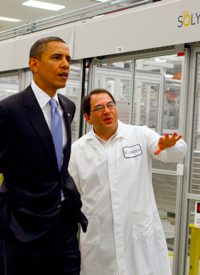
All in all, 12 green energy companies are in financial disorder after collectively receiving more than $6.5 billion in government assistance, five of which have already filed for bankruptcy, including Solyndra, Beacon Power, SpectraWatt, Evergreen Solar, and AES’ subsidiary Eastern Energy. According to CBS News, these green-tech ventures were junk-bond-rated companies with red flags planted all over them.
The first company under the spotlight is Beacon Power, a flywheel-based energy storage company which reaped $43 million from the Energy Department’s green energy program. The documents obtained by CBS News show that Standard & Poor’s had confidentially branded the Beacon project with a dismal "CCC+" rating, previous to the loan’s completion.
The S&P letter was addressed to Jonathan Silver, who recently resigned from his position as director of the Energy Department’s loan office. The report, dated May 20, 2010, read: "Pursuant to your request for a Standard & Poor’s rating on the above-referenced obligations, we have reviewed the information submitted to us and, subject to the enclosed Terms and Conditions, have assigned a Final Rating of "CCC+".
"Beacon is currently an unprofitable start-up that relies on equity markets for annual investments of roughly $16 million to offset its corporate-level cash burn," read the S&P report. "The project is the first-of-a-kind facility of this size and risks in completing construction on time and on budget."
Nonetheless, three months later the Energy Department gambled $43 million of taxpayer dollars on a loan guarantee issued to the company.
Asked whether he would personally provide financial backing to Beacon, economist Peter Morici replied, "Not on purpose." He added, "It’s a junk bond. But it’s not even a good junk bond. It’s well below investment grade." Indeed, Morici affirmed that the Energy Department was investing taxpayer dollars in a project that was not even a good junk bond. "This level of bond has about 70 percent chance of failing in the long term," he pointed out.
Other green-tech investments the Obama administration has championed are currently facing severe financial challenges. Nevada Geothermal, which develops "clean" electrical power from high temperature geothermal resources, displays warnings of multiple defaults in new SEC filings reviewed by CBS News. In fact, the company was already struggling to pay its bills when it harvested $98.5 million in federal loan guarantees.
Sen. Harry Reid (D-Nev.), one of the Obama administration’s most trusted congressional assets, was instrumental in securing the Energy Department’s financing for Nevada Geothermal. "Mr. Reid has taken the nascent geothermal industry under his wing," the New York Times reported last October, "pressuring the Department of Interior to move more quickly on applications to build clean energy projects on federally owned land and urging other member of Congress to expand federal tax incentives to help build geothermal plants, benefits that Nevada Geothermal has taken advantage of."
The Times pointed out that Nevada Geothermal’s financial misfortunes are all too reminiscent of Solyndra’s collapse, and that such trends have debunked the myth that government can effectively prop up enterprises which private investors avoid altogether:
After a series of technical missteps that are draining Nevada Geothermal’s cash reserves, its own auditor concluded in a filing released last week that there was "significant doubt about the company’s ability to continue as a going concern."
It is a description that echoes the warning issued in 2010 by auditors hired by Solyndra, which benefited from the same Energy Department loan guarantee before its collapse in August caused the Obama administration great embarrassment.
The parallels between the companies illustrate the risk inherent in building the clean energy marketplace in the United States, government officials and industry experts say. Indeed, the loan guarantee program exists precisely because none of these ventures are [sic] a sure bet.
Further, the Energy Department sponsored another company, SunPower, with a $1.2-billion loan to build the California Valley Solar Ranch in San Luis Obispo County, a project which was estimated to generate a mere 15 permanent jobs ($80 million per job). But the solar company posted $150 million in losses during the first half of 2011 and its debt reached nearly 80 percent of its market value by October. As if this weren’t enough, the company is also being hit with class action lawsuits for misstating its earnings.
First Solar, a manufacturer of thin film solar panels — and flagrant Washington lobbyer — secured a whopping $3 billion in federal loan guarantees, the most of any recipient. "First Solar spent $2.2 million on lobbying in Washington since 2007 and representatives met Obama administration officials before winning the aid," Bloomberg reported last month. "In California, the company gave $150,000 to campaigns last year, more than triple the $38,750 donated by BP Plc’s North America unit, according to the secretary of state’s office."
The result? The company was the worst performer in the S&P 500 index in 2011 after plunging 73 percent in New York trading through December 23.
Morici suggested that even somebody "as smart as" Energy Department Secretary Steven Chu — an award-winning scientist — shouldn't be playing "venture capitalist" with Americans' hard-earned tax dollars. "Tasking a Nobel Prize mathematician to make investments for the U.S. government is like asking the manager of the New York Yankees to be general in charge of America's troops in Afghanistan," he indicated. "It's that absurd."
Photo of President Obama at Solyndra: AP Images



